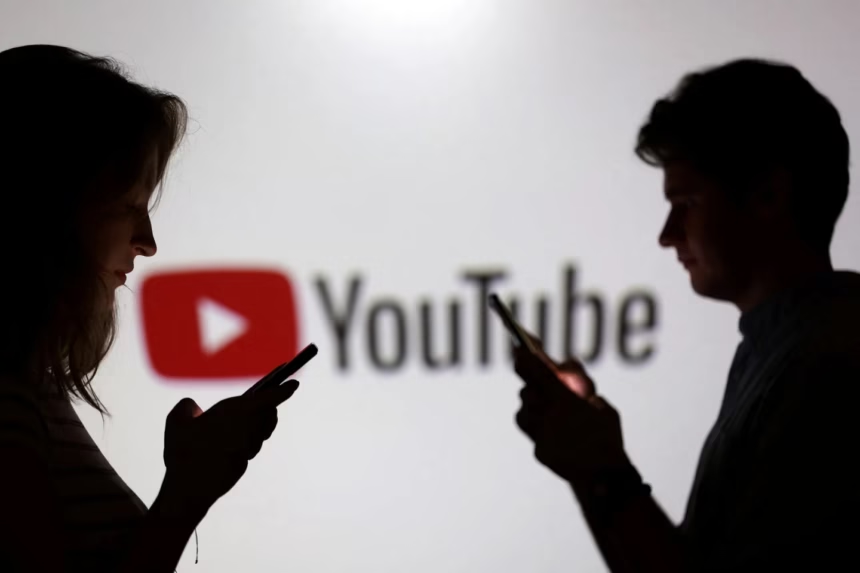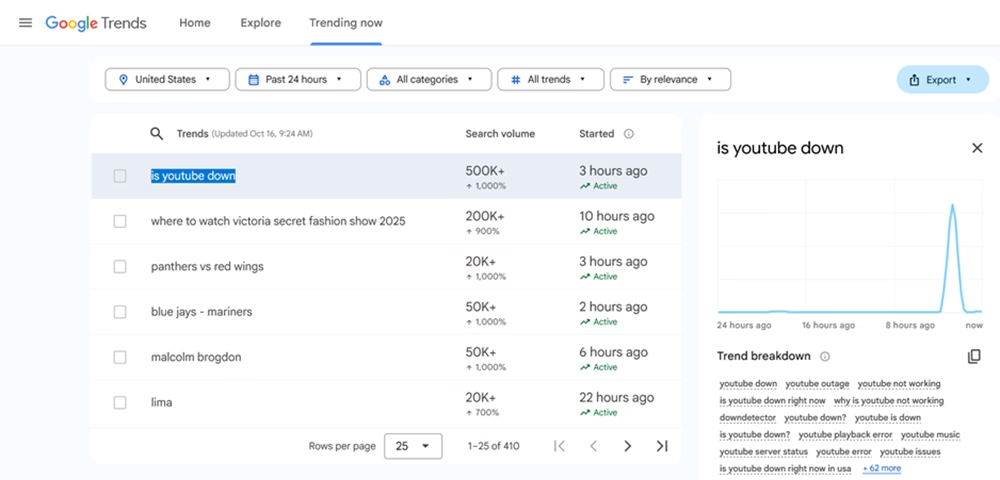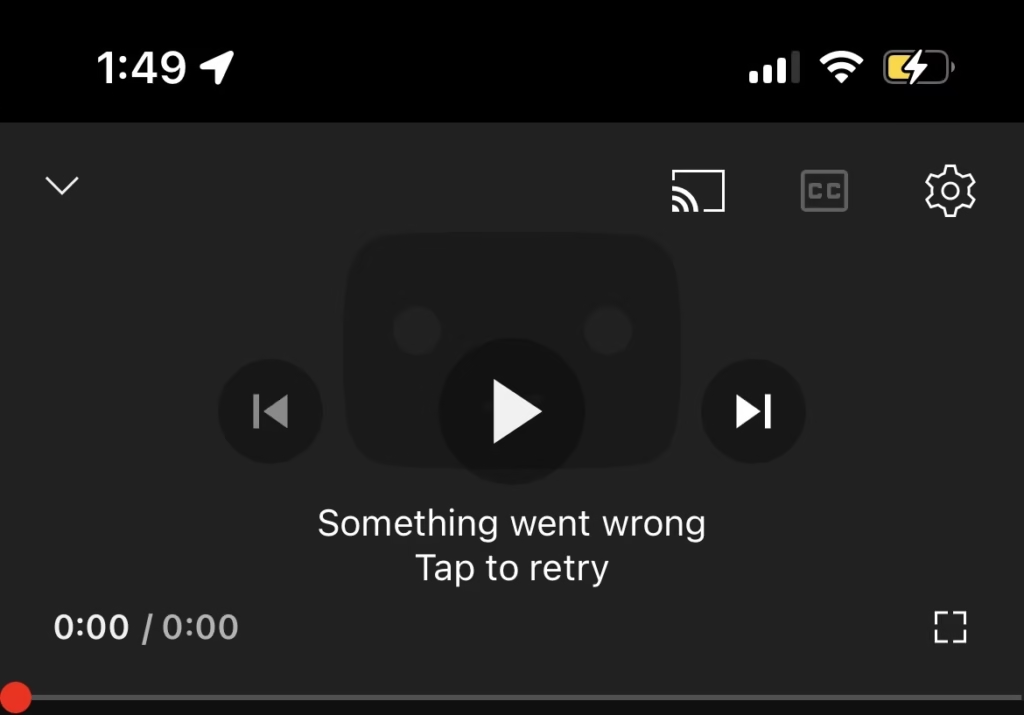BANGKOK – YouTube rarely stops. With more than 2.5 billion monthly users and around 14.8 billion visits last quarter, it sits at the centre of online video. On 16 October 2025, that grip loosened.
A sudden, large-scale outage left millions facing blank players and errors like “Something went wrong. Please try again,” prompting a rush of “is YouTube down?” searches across the globe. Interest surged in Thailand and many other countries within minutes.
The disruption began around 2 p.m. Bangkok time (UTC+7, about 7 a.m. UTC), lining up with early afternoon on the U.S. West Coast. Downdetector, which compiles user reports, showed a steep rise from that point. Complaints in the U.S. hit more than 366,000 by 7:55 p.m. ET.
Worldwide, reports topped 600,000 across the main site, mobile apps, YouTube Music, and YouTube TV. In Thailand, where YouTube is part of daily life for entertainment, learning, and shopping via live streams, users in Bangkok and Chiang Mai posted about frozen K-pop sessions and stalled drama marathons.
Is YouTube Down?
Google Trends reflected the panic. “Is YouTube down?” climbed to the top of searches in Thailand, the U.S., UK, India, Brazil, Australia, and across Europe and Latin America, counting hundreds of thousands of queries within hours. One X user in Bangkok joked, “YouTube down at peak traffic hour? Google, did you forget to pay the cloud bill?”, a line that echoed through viral threads worldwide.
This was not a local issue. Downdetector’s heat maps showed disruption spreading from Asia-Pacific through North America and into Europe. Major U.S. cities, including New York, Los Angeles, and Chicago, carried the heaviest load, with 54% of reports tied to video playback.
Creators felt the sharpest hit. A global creator economy worth tens of billions relies on steady views and ad spend. Thai creators, including mukbang and travel vloggers, reported failed uploads and no access to analytics, risking hours of lost revenue.
“It’s like the power going out in your studio mid-shoot,” an Indonesian YouTuber posted on X, tagging the official account. For viewers, the pause felt personal, from interrupted how-to videos at work to bedtime stories cut short.
The cause remained unclear at the time of writing. Google had not confirmed a root issue, drawing familiar flak over limited detail during outages. Early guesses from outage watchers pointed to a backend fault in Google’s cloud, possibly a cascading failure across content delivery networks that push YouTube’s huge video traffic.
YouTube Error
YouTube runs on Google’s large-scale cloud setup, routing requests through thousands of edge servers to keep delays low. A bad configuration during maintenance, or a sudden traffic spike tied to midweek viral content, could have created a domino effect, straining authentication and blocking video loads.
Past patterns fit. In June 2025, a U.S.-heavy outage traced back to a faulty load balancer update and lasted over an hour. Industry reports have flagged a rise in cloud weak points year over year, which increases the chance that a single flaw in a distributed system can ripple widely.
A DDoS attack also remained possible, given rising geopolitical tension and hacktivist attention on large platforms. Without a postmortem from Google, it stayed in the realm of theory. The human impact was clearer.
In Thailand, where internet use is about 85% and YouTube holds roughly 70% of video viewing, daily routines took a hit, from office breaks to street food stall streams. X filled with #YouTubeDown posts, plus memes about users “talking to their screens like it’s a bad date.”
On the recovery side, YouTube’s engineers moved fast. The @TeamYouTube account posted within 20 minutes of the spike: “If you’re not able to play videos on YouTube right now – we’re on it! Thanks for your patience, and you can follow along here for updates.” By 5:30 p.m. PT (around 8:30 a.m. in Bangkok the next day), video playback returned for most users.
Traffic Spikes on TikTok and Vimeo
The likely fix involved shifting traffic to backup CDNs, hot-patching faulty code, and scaling servers in troubled regions. YouTube Music and YouTube TV stabilized a little later, yet the broader service recovered in under 90 minutes. “We’re investigating the root cause and will provide more details soon,” a later post said, pointing to a status page that shared limited information.
That brevity cut both ways. Rapid updates and a swift fix kept losses in check. Creators may have missed out on roughly $10 million in ad revenue, based on rough Backlinko comparisons with past outages.
Sparse details fuelled suspicion, though, with X threads floating theories about “shadowbans” and “tests.” In Thailand, the event also highlighted regional gaps. Under-provisioned edge nodes in parts of Southeast Asia can slow recovery, as seen during the 2024 Fastly CDN incident.
The outage underscored how much the world leans on one platform. Traffic rose on TikTok and Vimeo during the blackout, yet neither matches YouTube’s reach or creator tools. Google, backed by huge annual revenue, can absorb short-term shocks.
Users and creators carry the immediate pain. Expect louder calls for more redundancy, more investment at the edge, and clearer playbooks when things break. Until then, another “is YouTube down?” spike sits one glitch away.
Thai users have already turned it into a punchline. “YouTube down? Time for a real conversation, with actual humans.” If only servers could answer back.
















